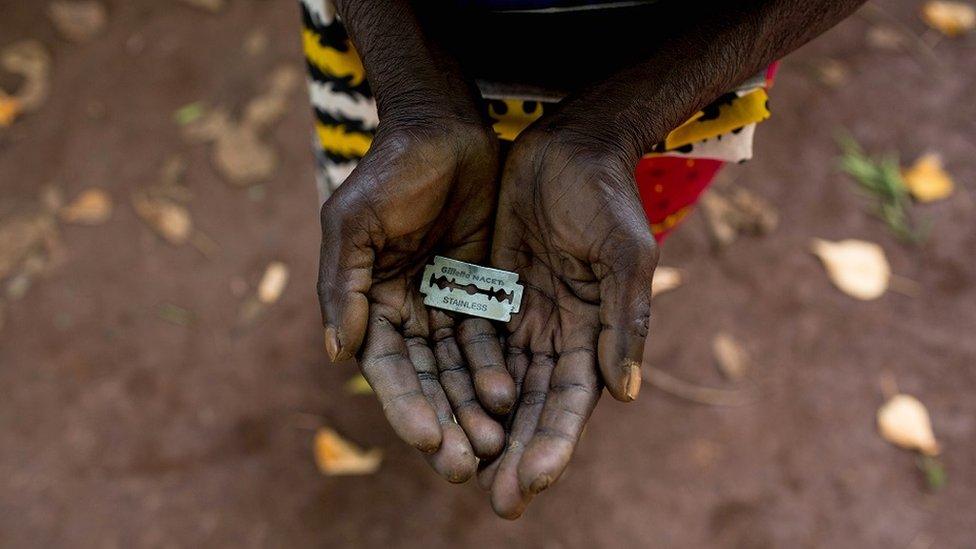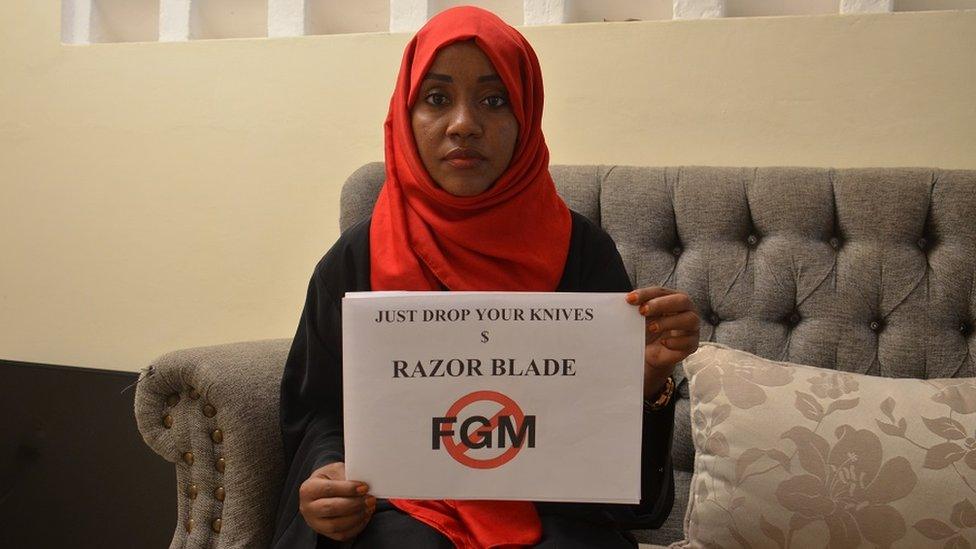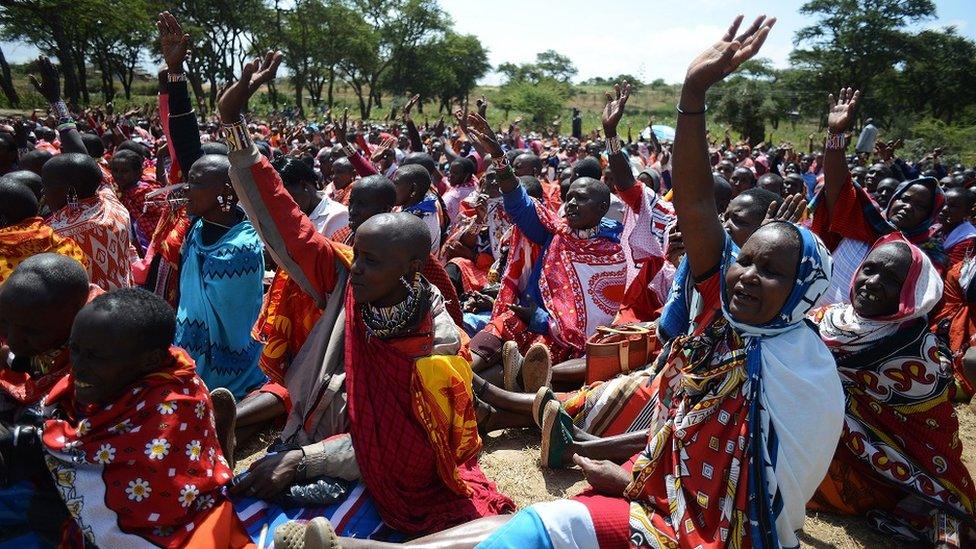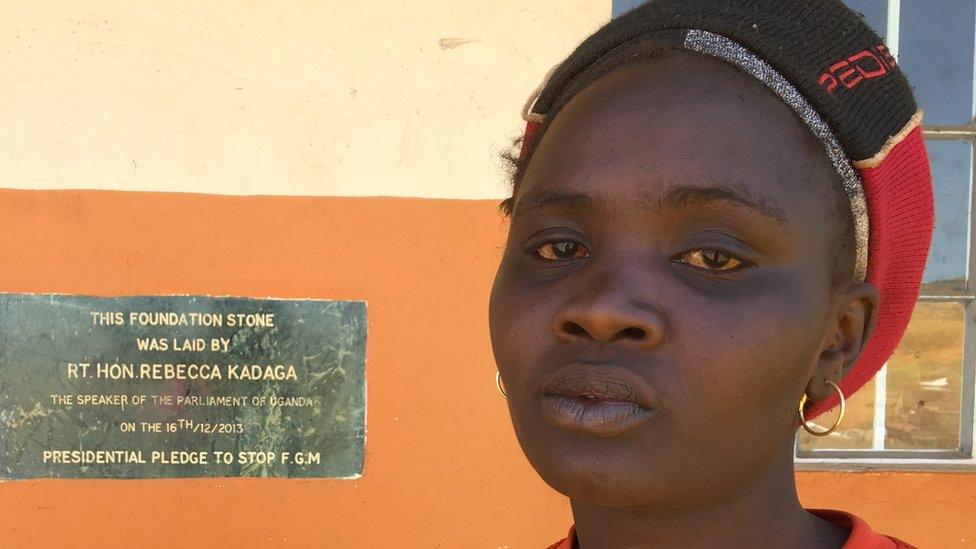What is FGM, where does it happen and why?
- Published

This woman in Mombasa, Kenya shows the razorblade she has used on girls' genitals
It's estimated that 200 million girls and women alive today have undergone some form of FGM, according to the United Nations (UN).
It is calling for an end to FGM on International Day of Zero Tolerance for Female Genital Mutilation on 6 February.
FGM can cause physical and mental health problems that go on to affect women in later life, as Bishara Sheikh Hamo, from the Borana Community in Kenya's Isiolo County explains.
What are the four types of FGM?
"I underwent FGM when I was 11 years old," says Bishara. "I was told by my grandmother FGM is a requirement for every girl, that it made us pure."
But what Bishara did not know was that it would leave her with irregular periods, bladder problems, and recurrent infections. She was only able to give birth via Caesarean section.
She is now an anti FGM campaigner.
What is Female Genital Mutilation?

Unicef estimates more than 200 million girls and women have suffered FGM in Africa, Asia and the Middle East, but also within migrant communities where FGM is common - in Spain, 18,000 girls are considered to be at risk
Female genital mutilation, or FGM for short, is the deliberate cutting or removal of a female's external genitalia.
It often involves the removal or cutting of the labia and clitoris, and the World Health Organization describes it as "any procedure that injures the female genital organs for non-medical reasons".
Omnia Ibrahim, a blogger and film maker from Egypt, says FGM is distressing and damages women's relationships and how they feel about themselves.
"You are an ice cube. You don't feel; you don't love; you don't have desire," she says.
Omnia says she has struggled with the psychological impact of FGM all her adult life. She says her community taught her "that a body means sex and that sex is a sin. To my mind my body had become a curse".
"I used to always ask myself: did I hate sex because I was taught to be afraid of it, or do I really not care for it?"

Bishara became an anti FGM campaigner after struggling to cope with her mutilation
In Kenya, Bishara told the BBC FGM was carried out on her, together with four other girls. "I was blindfolded. Then she [the cutter] tied my hands behind my back. My legs were spread open and then they pinned down my labia."
"Then after a few minutes, I felt a sharp pain. I screamed, I yelled, but no-one could hear me. I tried to kick myself free, but a vice-like grip held my leg.
She says it was "pathetic. It's one of the most severe types of medical procedures, and so unhygienic. They used the same cutting tool on all of us girls".
The only pain relief available was a traditional remedy: "There was a hole in the ground, and they kept herbs in the hole. Then they tied my legs like a goat and rubbed the herbs on me. Then they said 'next girl, next girl,' and they took another girl..."
Although FGM it is illegal in many countries, it is still routinely carried out in parts of Africa, Asia and the Middle East - and also among the diaspora of those countries where FGM is common.
There are four types of FGM
Type 1: Clitoridectomy. That's the total or partial removal of the sensitive clitoris and its surrounding skin.
Type 2: Excision. The partial or total removal of the clitoris plus the removal of the labia minora, or inner skin folds surrounding the vagina.
Type 3: Infibulation. The cutting and repositioning of the labia minora and the labia majora - the outer skin folds that surround the vagina. This often includes stitching to leave only a small gap.
This practice is not only extremely painful and distressing, it's also an ongoing infection risk: the closing over of the vagina and the urethra leaves women with a very small opening through which to pass menstrual fluid and urine.
In fact, sometimes the opening can be so small that it needs to be cut open to allow sexual intercourse or birth - often causing complications which harm both mother and baby.
Type 4: This covers all other harmful procedures like pricking, piercing, incising, scraping and cauterising the clitoris or genital area.
Why does it happen?

Some Kenyan Maasai women voiced opposition to a FGM ban because of fears that uncut girls would not be able to get married or become promiscuous
The most frequently cited reasons for carrying out FGM are social acceptance, religion, misconceptions about hygiene, a means of preserving a girl or woman's virginity, making the woman "marriageable" and enhancing male sexual pleasure.
In some cultures FGM is regarded as a rite of passage into adulthood, and considered a pre-requisite for marriage.
Although there are no hygienic advantages or health benefits to FGM, practising communities believe that women's vaginas need to be cut - and women who have not undergone FGM are regarded as unhealthy, unclean or unworthy.
Often it's performed against their will, and health professionals worldwide consider it a form of violence against women and a violation of their human rights. When FGM is inflicted on children, it is also seen as a form of child abuse.
Where is FGM practised?

Many of the women surveyed by Unicef and the WHO said it was taboo to even discuss FGM in their communities for fear of attracting criticism from outsiders, or - in those places where FGM is illegal - for fear it would lead to prosecution of family or community members.
Therefore figures are based on estimates.
The above map was put together by The Woman Stats Project, who have collated research on the issue, including data from the UN and Unicef.
It is estimated by the UN that although FGM is concentrated in 30 countries in Africa and the Middle East, it is also practiced in some countries in Asia and Latin America. And amongst immigrant populations living in Western Europe, North America, Australia and New Zealand, the UN says.
According to a Unicef report carried out in 29 countries in Africa and the Middle East, the practice is still being widely carried out, despite the fact that 24 of these countries have legislation or some form of decrees against FGM.
In countries such as the UK, where FGM is illegal, expert and barrister Dr Charlotte Proudman says it is increasingly being performed on babies and infants. Therefore it is "almost impossible to detect" as the girls are not in school or old enough to report it.
Recently a mother in London became the first person in the UK to be found guilty of carrying out FGM on her three-year-old daughter. She will be sentenced on 8 March.
- Published6 February 2019
